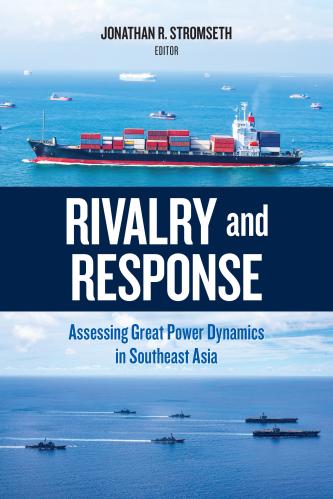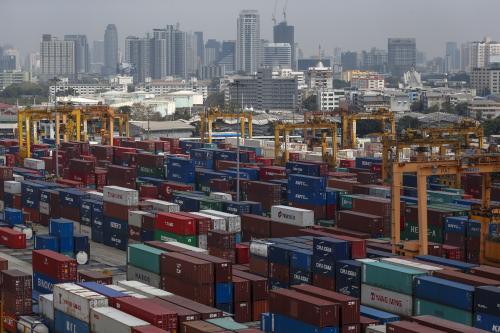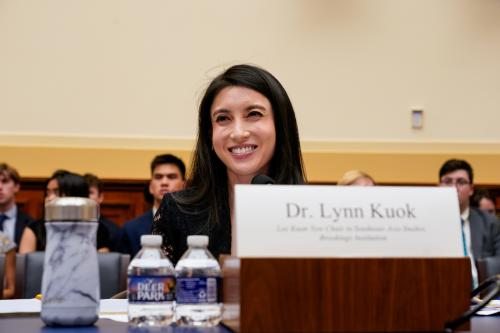As the world looks forward with hope for recovery from the pandemic recession, what are the prospects in Southeast Asia? Will it make a swift return to reasonably robust growth in 2021, as some forecasts suggest?
Even a quick return to growth would likely only mask deep economic and social scars. The latest International Monetary Fund forecasts, for instance, suggest that income per capita in the ASEAN-5 economies (Indonesia, Malaysia, Philippines, Thailand, and Vietnam) will still be 6% lower in 2024 than the level that was expected before the pandemic struck. For the Philippines, which faces the worst economic outlook, the scarring is expected to be twice as deep, with income per capita remaining 12% lower than previously expected. Progress in addressing poverty, precarious employment, and human development will likely have been similarly set back. Importantly, the longer economies remain depressed, the worse these scarring effects are likely to be — with the risk of eventual political reverberations inevitably rising.
Although the outlook is beset by uncertainty, three key factors have been crucial in shaping Southeast Asia’s experience of the crisis to date and will be pivotal in what comes next.
Key factors shaping Southeast Asia’s COVID-19 crisis
1. Controlling the virus
The first is the clear centrality of controlling the virus itself to limit the economic damage. The contrasting experiences of Vietnam, Indonesia, and Philippines epitomize the Southeast Asian story (Figure 1).

Vietnam has been the stellar example: It is one of few economies in the world to eke out positive economic growth in 2020 on the back of a prompt and highly successful public health response. That allowed Vietnam to quickly reopen its economy and stage a strong recovery.
Indonesia’s government, by comparison, was reluctant to take actions that would undermine the economy in the short term, having only belatedly imposed social distancing restrictions while failing to mount an effective public health response. Indonesia experienced a shallower recession than many others. But as it failed to contain the virus, its economic recovery thereafter has been weak.
The Philippines, meanwhile, stands out as having experienced the worst of both worlds: It imposed harsh lockdown restrictions and still failed to control the spread of the virus. The Philippines’ economy fell 14% (compared to its pre-COVID level) in the second quarter of 2020, and was still 9% smaller by the end of the year, placing it as one of the worst economic performers globally.
2. International trade
The second key factor shaping Southeast Asia’s crisis has been the role of international trade. Global trade has held up surprisingly well, and this has been especially beneficial for Southeast Asia as a heavily trade-driven region. Although trade led the global downturn, it has also led the recovery — especially as public lockdowns around the world were gradually eased and as Western governments rolled out huge fiscal packages. A surge in demand for personal protective equipment (PPE), electronics, and other products to facilitate working from home has also been especially helpful for Southeast Asia’s exports. By mid-2020, the region’s merchandise exports had fallen by almost one-fifth, but by October this had recovered to be slightly higher than the pre-pandemic level (Figure 2).

3. Macroeconomic policy
The third crucial factor shaping Southeast Asia’s crisis has been the responsiveness of macroeconomic policy. Most governments in the region have predictably been unable to match the fiscal largesse of their Western counterparts. Singapore and Thailand aside, the average COVID-19 fiscal response in Southeast Asia was 3% of GDP in 2020 (Figure 3), compared to 13.5% of GDP at the global level and considerably higher in major Western economies. Nonetheless, fiscal policy in Southeast Asia has still been very expansionary — particularly if compared to past crises — and this has played a crucial role in limiting the economic and social fallout from the pandemic.

While the nature of the crisis required fiscal policy to play the leading role, the actions of some central banks in the region were also crucial, most notably in Indonesia and the Philippines. Central banks in both countries stepped forward to not only purchase significant quantities of domestic government bonds in the secondary market but also to directly finance a large part of the government’s budget deficit. This was a game-changer for the path of the crisis — first by stabilizing local bond markets in the face of severe capital outflows early in the pandemic, and then by ensuring that the large budget deficits necessitated by the crisis could be financed despite limited market funding opportunities and little international help. Not long ago, such actions by central banks in emerging economies might have caused even sharper outflows. Instead, the market response was surprisingly muted — in part reflecting the improved credibility these central banks have built up over many years but also enabled by the easing of outflow pressures as rich country central banks unleashed a flood of global liquidity.
What comes next?
As is the case everywhere, there is enormous uncertainty around the speed at which Southeast Asia will be able to recover from the pandemic recession and to what extent the region will be left with long-lasting economic and social scars.
Recovery in individual countries will remain weak and incomplete as long as the domestic spread of the virus is not under control. In this respect, the regional outlook is mostly not promising. The spread of the virus continues in Indonesia, Philippines, and Malaysia, with sporadic outbreaks in other countries. Meanwhile, new and more dangerous COVID-19 variants are a threat, and vaccine rollout is likely to be slow. Only Singapore seems on track to reach widespread vaccination this year. Progress elsewhere risks being far slower.
The trade outlook is more promising. On the one hand, outsized demand for PPE and electronics will probably dissipate. On the other hand, there is likely to be a continued strong pick-up in global demand if major economies are able to remain on the recovery path. Demand emanating from the United States will be particularly important. The recent passage of $1.9 trillion in additional budget measures has taken the total scale of U.S. fiscal stimulus planned for this year to 13% of GDP. The exact size of the demand multiplier is uncertain, given the uniqueness of the pandemic recession. But combined with significant pent-up savings, a surge in U.S. demand appears in the pipeline. And a good amount of this will leak into higher U.S. imports, suggesting global trade will continue to be of key economic support in the year ahead.
The relatively small fiscal response to date in the region already does not bode well for a strong recovery.
Finally, maintaining expansionary macroeconomic policies will be crucial. The relatively small fiscal response to date in the region already does not bode well for a strong recovery. More troubling, global interest rates have begun to rise as markets adjust to the prospect of higher future U.S. inflation and an earlier tightening in monetary policy than previously expected — reflecting improving U.S. recovery prospects, the scale of U.S. fiscal stimulus this year, and a possible shift towards greater fiscal activism in the future. For Southeast Asia, this will mean increased borrowing costs and pressure on currencies that will make it harder to maintain the expansionary policy settings needed for recovery. Worse, the specter of a re-run at some point of the 2013 “taper tantrum” — which destabilized Indonesia’s financial markets in particular and prompted a sharp tightening in policy — is now a material risk.
-
Acknowledgements and disclosures
Rachel Slattery did graphic design for this post. Adrien Chorn assisted with editing.
The Brookings Institution is committed to quality, independence, and impact.
We are supported by a diverse array of funders. In line with our values and policies, each Brookings publication represents the sole views of its author(s).









Commentary
Southeast Asia’s post-pandemic recovery outlook
March 15, 2021